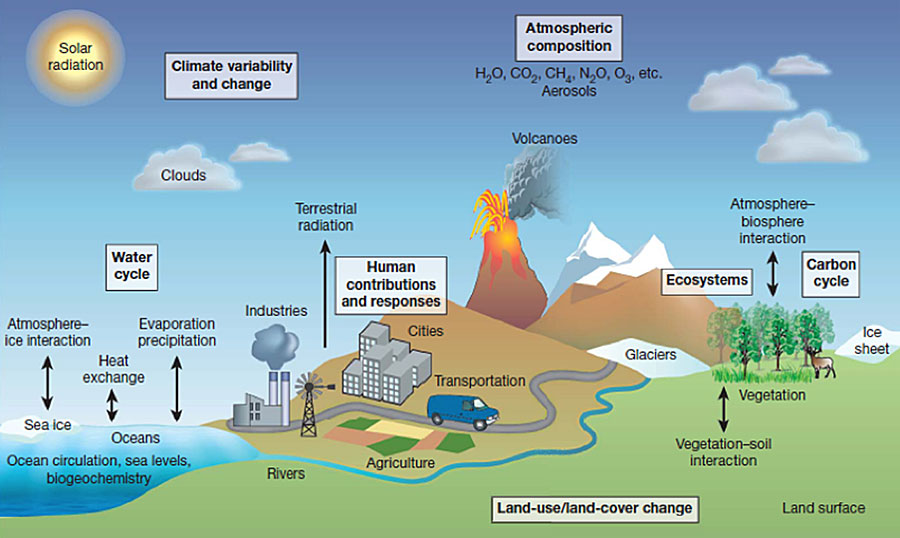GFDL Earth System Models
Background
GFDL has constructed Earth System Models (ESMs) to advance our understanding of how the Earth’s biogeochemical cycles, including human actions, interact with the climate system. Like GFDL’s physical climate models, these simulation tools are based on an atmospheric circulation model coupled with an oceanic circulation model, with representations of land, sea ice and iceberg dynamics. ESMs incorporate interactive biogeochemistry, including the carbon cycle. Building the ESMs has been a large collaborative effort involving scientists from GFDL, Princeton University, Department of Interior and other institutions, to study climate and ecosystem interactions and their potential changes, from both natural and anthropogenic causes.
The atmospheric component of the ESMs includes physical features such as aerosols (both natural and anthropogenic), cloud physics, and precipitation. The land component includes precipitation and evaporation, streams, lakes, rivers, and runoff as well as a terrestrial ecology component to simulate dynamic reservoirs of carbon and other tracers. The oceanic component includes features such as free surface to capture wave processes; water fluxes, or flow; currents; sea ice dynamics; iceberg transport of freshwater; and a state-of-the-art representation of ocean mixing as well as marine biogeochemistry and ecology.
While carbon is necessarily included as the basic building block of ecosystems undergoing terrestrial and oceanic chemistry, associated chemical and ecological tracers which control nutrient limitation, plant biomass, productivity, and functional composition are also included. Chemical tracers are also tracked in the atmosphere. ESMs capture numerous types of emissions, variations of land surface albedo due to both natural vegetation changes and land use history such as agriculture and forestry, and aerosol chemistry. Adding these different components to the ESM represents a major step forward in simulating the Earth’s ecological systems in a comprehensive and internally consistent context.

Figure: Major natural and anthropogenic processes and influences on the climate system addressed in scenarios.
The climate system consists of five interacting components: the atmosphere, the hydrosphere, the cryosphere, the land surface and the biosphere. Scenarios of emissions and other drivers are used to assess the impact of a range of human activities on these components. Changes in climate described in climate scenarios are major drivers of changes in both natural and human systems. Impacts on ecosystems, natural resources, economic activities and infrastructure, and human well-being, depend not only on climate change, but also on other changes in the environment (depicted in environmental scenarios) and the capacity of societies and economies to buffer and adapt to impacts (addressed in scenarios of vulnerability and adaptive capacity). Closer integration of scenarios is required to address feedback loops and other issues, such as the ecological and economic implications of different sets of adaptation and mitigation policies. Figure from U.S. Climate Change Science Program. Strategic Plan for the Climate Change Science Program, Final Report (eds Subcommittee on Global Change Research) Figure 2.5 19 (US Climate Change Science Program, Washington DC, 2003).
Earth System (ESM4)
GFDL’s ESM4.1 consists of:
- AM4.0 atmosphere at approximately 1o resolution with 49 levels of comprehensive, interactive chemistry and aerosols (including aerosol indirect effect) from precursor emissions
- OM4 MOM6-based ocean at ½o resolution with 75 levels using hybrid pressure/isopycnal vertical coordinate
- SIS2 sea ice with radiative transfer and C-grid dynamics for compatibility with MOM6
- LM4.1 land model with a new vegetation dynamics model with explicit treatment of plant age and height structure and soil microbes, with daily fire, crops, pasture, and grazing tiles
- COBALTv2 ocean biogeochemical component representing ocean ecological and biogeochemical interactions
- Fully Interactive dust and iron cycling between land-atmosphere and ocean
ESM2M and ESM2G
Our first prototype model, ESM2.1, evolved directly from GFDL’s successful CM2.1 climate model (Delworth et al. 2006 ). Building on this, we produced two new models representing ocean physics with alternative numerical frameworks to explore the implications of some of the fundamental assumptions embedded in these models.The models differ mainly in the physical ocean component. In one model, ESM2M, pressure-based vertical coordinates are used along the developmental path of GFDL’s Modular Ocean Model version 4.1. In the other, ESM2G, an independently developed isopycnal model using the Generalized Ocean Layer Dynamics (GOLD) code base was used.
Comparison between these two models allows us to assess the sensitivity of the coupled climate-carbon system to our assumptions about ocean formulation. Both ESM2M and ESM2G utilize a more advanced land model, LM3, than was available in ESM2.1 including a variety of enhancements (Milly et al., in prep). While the models demonstrate similar overall scale fidelity, they have important differences in both their thermocline characteristics, deep circulation, ventilation patterns and El Nino variability that suggest critical roles for details of ocean configuration in the coupled carbon climate system.
CMIP EXPERIMENTS using GFDL’s ESMs
GFDL has completed all of its integrations (about 100 in total) with ESM2M and ESM2G, for the CMIP5 protocol (Taylor et al. 2012, http://pcmdi-cmip.llnl.gov/cmip5/). A series of integrations were made where the atmospheric CO2 concentration was specified. These experiments include an 1860 control, historical, 4 future scenarios (RCP 2.6, 4.5, 6.0 and 8.5) and several idealized integrations to study various aspects of the model response to forcing. In addition, we made a number of integrations where the model predicts its own atmospheric CO2 concentrations. These runs include an 1860 control, historical and future (RCP8.5) simulations. Finally, a number of integrations were made to explore various aspects of the carbon feedbacks in these models.
For more details on the model and simulations performed, see the METAFOR questionnaire web pages and instructions therein.
To obtain CMIP5 ESM data click here.

Basic structure of GFDL’s Earth System Model.


